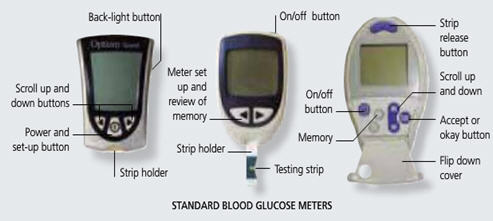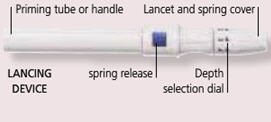Monitoring equipment for testing your blood glucose level
Specialized equipment is available for you to test your blood glucose level wherever you are. Testing is usually done by inserting a blood testing strip into a blood glucose meter and applying a blood sample (obtained using a lancet) to the testing strip to obtain a reading. Your health professional can help you decide what type of equipment is best for you. You can also get information from books, the internet, or a national diabetes organization. Testing strips and lancets are obtained by prescription. You can buy meters from a pharmacy or your health professional may give you a starter kit.
Blood glucose meters
Battery-operated devices called glucose meters analyze the amount of glucose in the blood sample on your testing strip and then display the result on a screen. With most meters, you insert a testing strip into the meter before applying your blood to a specific area on the strip. The meters use one of two different methods to analyze the results but both are highly accurate and give results ranging from 10 to 600 mg/dl. Some meters also have additional features – for example, one type includes its own lancing device for collecting a blood sample.

Lancing devices and blood glucose strips
Most lancing devices consist of a hand-held tube into which you put a needle (lancet). A dial enables you to choose how deeply the needle enters your site. Lancets are used with a lancing device to prick your skin. They are designed to be used once to avoid infection and to make sure the needle is as sharp as possible. Blood testing strips usually come in packs of 25 or 50. Always check the expiry date of your blood testing strips before use.

Choosing a meter
Considering the following factors will help you to choose a glucose meter.
Size Some meters are smaller and more compact than others. If you have problems with dexterity, you may find a larger meter helpful.
Result display Meters with large displays may be easier to read if you have vision problems. Some meters just give you your test result, others give the date and time.
Averages Many meters provide you with an average of your readings, for example, over the previous 7, 14, or 28 days.
Computer download facility Some meters have a facility that allows you to download your results and analyze them on a computer.
Size of blood sample The amount of blood you need to put on your strip can vary from 0.3 to 10 microliters.
Memory Meters vary greatly in the number of results they can store. Some can store 10; others can store up to 450. A large memory is useful if you aren’t always able to write down your results.
Timing After you have applied blood, meters can take anything from 5 to 45 seconds to give you a result.
Testing sites All meters can analyze blood from your fingertips. Some can also analyze blood from your forearm, the palm of your hand, or your abdomen.
Additional features Some devices combine a blood glucose meter with other features, such as a lancing device.

